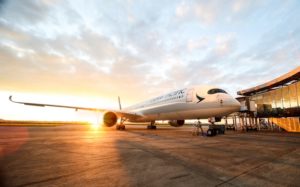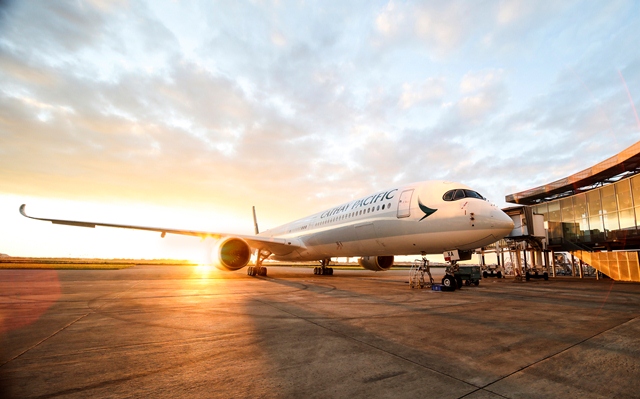 The Cathay Pacific group described 2019 as a turbulent year as it reported an attributable profit of HKD1.691 billion (US$217.616 million) for the year, a 27.9% decline compared with HKD2.345 billion profit for 2018, even as the Hong Kong flag carrier braces for “substantial loss” ahead owing to the spread of the new coronavirus (COVID-19).
The Cathay Pacific group described 2019 as a turbulent year as it reported an attributable profit of HKD1.691 billion (US$217.616 million) for the year, a 27.9% decline compared with HKD2.345 billion profit for 2018, even as the Hong Kong flag carrier braces for “substantial loss” ahead owing to the spread of the new coronavirus (COVID-19).
The airline in a statement on March 11 said earnings per share was HKD43.0 cents in 2019 compared to an earnings per share of HKD59.6 cents in 2018.
“2019 was a turbulent year for the Cathay Pacific Group. With our three-year transformation programme starting to bear fruit we delivered a positive performance in the first half of 2019 notwithstanding a difficult environment brought about by geopolitical and trade tensions,” said Patrick Healy, Cathay Pacific group chairman.
“However, with social unrest in Hong Kong intensifying over the second half of the year and mounting US-China trade tensions, we experienced a sharp drop in both inbound and outbound passenger traffic. We were faced with an incredibly challenging environment to operate as the Hong Kong economy slipped into recession. As a result, our second-half results—traditionally stronger compared to first-half results—fell well below what we would have hoped for.”
The group reported an attributable profit of HKD344 million in the second half of 2019 compared to an attributable profit of HKD1.347 billion in the first half of 2019 and an attributable profit of HKD2.608 billion in the second half of 2018.
Sister airlines Cathay Pacific and Cathay Dragon reported an attributable loss of HKD434 million in the second half of 2019 compared to an attributable profit of HKD675 million in the first half of 2019 and an attributable profit of HKD1.253 billion in the second half of 2018.
The company said cargo demand was depressed all year as a result of US-China trade tensions and was noticeably below that of 2018. However, it did pick up later in 2019 during the traditional high season, reflecting new consumer product, specialist airfreight shipments and restocking ahead of holiday periods. Exports from Mainland China and Hong Kong to trans-Pacific and European markets were more encouraging later in the year.
“Nevertheless, the cargo business performed significantly below expectations in 2019,” said the company.
“Overall, passenger and cargo yields were under intense pressure in 2019 and both were below those seen in 2018. Events in Hong Kong in the second half of the year significantly reduced load factors, forward bookings and the number of passengers we carried. Inbound traffic was hit hard, particularly on short-haul and Mainland China routes, while outbound traffic also decreased. Demand for premium travel was weak and we became increasingly reliant on lower-yielding transit traffic. We carried 0.7% fewer passengers in 2019 than in 2018,” it added.
For Cathay Pacific and Cathay Dragon, passenger revenue in 2019 was HKD72.168 billion, a decrease of 1.3% compared to 2018. Traffic increased by 2.9%, while capacity increased by 5.1%, albeit this was less than originally expected. Consequently the load factor decreased by 1.8 percentage points, to 82.3%. Yield decreased by 3.9% to HK53.6 cents, reflecting a strong US dollar, intense competition and reduced travel in the second half of 2019 as a result of the social unrest in Hong Kong. Inbound and outbound traffic, particularly on short-haul Mainland China routes, substantially reduced from August to December.
Cargo revenue in 2019 was HKD21.154 billion, a decrease of 14.2% compared to 2018. Traffic decreased by 6.7%, whilst capacity decreased by 0.3%. Consequently the load factor decreased by 4.4 percentage points, to 64.4%. Yield decreased by 7.9% to HKD1.87, reflecting a strong US dollar and weakened cargo demand resulting from intensified US-China trade tensions.
Prospects extremely challenged
On the group’s prospects, following the impact of social unrest in Hong Kong in the latter half of 2019, the first half of 2020 was expected to be extremely challenging financially, with an already reduced winter season capacity. This has been exacerbated by the significant negative impact of COVID-19.
“It is difficult to predict when these conditions will improve. Travel demand has dropped substantially and we have taken a series of short-term measures in response. These have included a sharp reduction of capacity in our passenger network. Despite these measures we expect to incur a substantial loss for the first half of 2020,” said Healy.
“We expect our passenger business to be under severe pressure this year and that our cargo business will continue to face headwinds. However, we are cautiously optimistic about cargo following the recent reduction in US-China trade tensions and we have maintained our cargo capacity intact.”
Photo courtesy of Cathay Pacific





